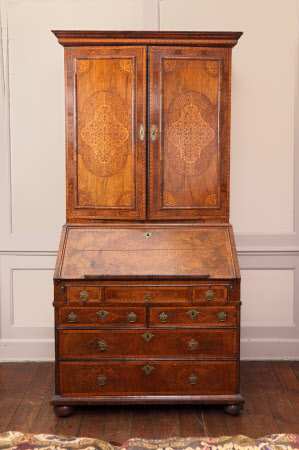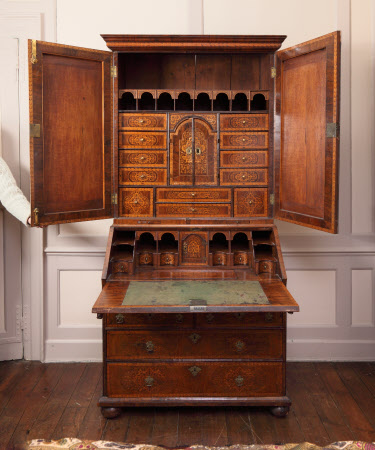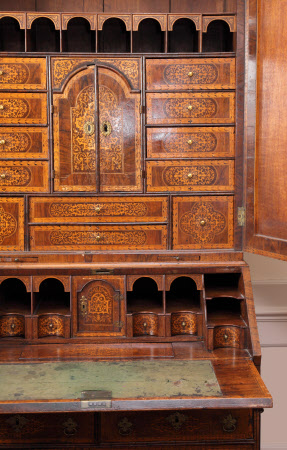Bureau bookcase
Category
Furniture
Date
circa 1710 - 1720
Materials
Walnut, burr walnut veneer, holly marquetry inlay, oak, deal and walnut construction. Brass locks, handles and catches.
Measurements
212 cm (H); 108 cm (W); 60 cm (D)
Place of origin
London
Order this imageCollection
Gunby Hall Estate, Lincolnshire
NT 637179
Summary
A marquetry inlaid and feather banded walnut and burr walnut bureau cabinet, English, probably London, circa 1710 - 1720. The upper section with a pair of panelled cupboard doors below a moulded cornice, inlaid with 'seaweed' marquetry or arabesque marquetry designs and enclosing a fitted interior of a shelf above eight arcaded open compartments below which is a pair of cupboard doors, surrounded by an arrangement of twelve drawers, all inlaid with conforming marquetry and with two candles slides to the base. The lower section with a hinged fall enclosing a further fitted interior of drawers and open compartments centred by a cupboard door, the leather inset writing surface with a lidded well behind. Below the fall are one false central drawer, flanked by two short drawers above two further short drawers and two long drawers, raised on later bun feet, further 'seaweed' marquetry throughout. Most brass handles are later replacements, the locks, including a superb four bolt lock to the fall, key and lock plates and catches are original.
Full description
The bureau cabinet is of excellent quality and workmanship, almost certainly from a London workshop. The fashion for 'seaweed' marquetry or arabesque marquetry was short lived and most examples were produced between 1690 and 1710. Comparable examples, albeit slightly earlier in date, include a bureau at Montacute House (NT 597512) a cabinet at Wightwick Manor (NT 1288166) and a cabinet on chest in the Canons Ashby collection (NT 494902). Not evident in an inventory taken at Canons Ashby in 1708 but probably the 'large inlaid Cabinet, wth Chest of Drawers under it' listed in the inventory taken 1717, and so presumed to have been purchased by Edward Dryden in the intervening years. Traditionally associated with Gerrit Jensen (d. 1715) it is, in fact, of a type that was probably produced by a number of London's leading cabinet-makers. A marked piece of cabinet work by Samuel Bennet, Monmouth Square, London (fl.c.1695–d.1741) is illustrated in Gilbert's 'Marked London Furniture' and Cescinsky & Gribble's 'English Furniture and Woodwork' p. 276 which displays similar use of marquetry panels and banding, he is also known to have produced bureaux in a similar form. (James Weedon, July 2019)
Provenance
Bequest in 1982 from Freda Leith Hay Clark, a cousin of the Langtons.


